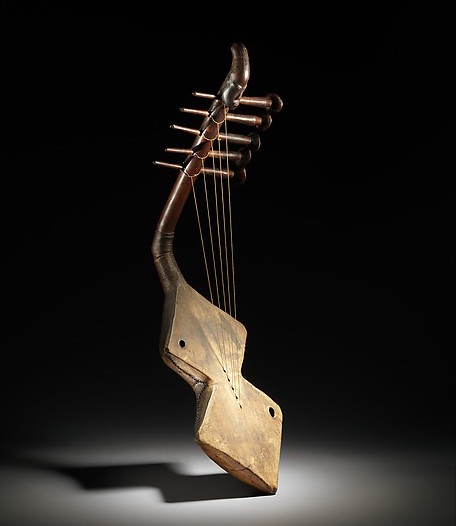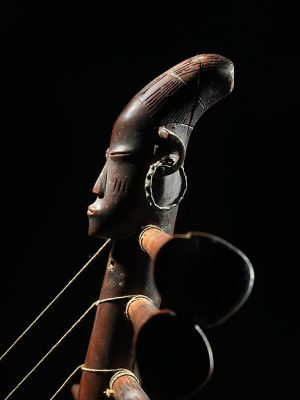
Figurative Harp (Domu), 19th–20th century (Mangbetu peoples, Democratic Republic of the Congo), wood and hide, 52.1 x 48.3 cm (The Metropolitan Museum of Art, New York)
In northern Democratic Republic of Congo, the Mangbetu peoples established an influential centralized kingdom that reached its apex of power during the second half of the nineteenth century. Mangbetu aristocrats surrounded themselves with a variety of finely crafted utilitarian objects, including boxes, stools, weapons, and musical instruments. The opulence of the kingdom captured the attention of European visitors to the region, who described Mangbetu court life and its artistic traditions in glowing terms.

Carved head (detail), Figurative Harp (Domu), 19th–20th century (Mangbetu peoples, Democratic Republic of the Congo), wood and hide, 52.1 x 48.3 cm (The Metropolitan Museum of Art, New York)
This musical instrument, with freestanding strings that rise in a horizontal plane from its belly to neck, is a harp. The curved neck ends in a finely carved head with partially open mouth, as if in song. The wooden sound box is covered with carefully stitched animal hide. When playing the harp, a musician sat with the sound box on his lap and the neck pointing away from him. He held the neck with his left hand and plucked the strings with both. The harp player adjusted the tone of each string by turning the tuning pegs set in the harp’s neck. Harp players performed for the entertainment of community groups and, as they played, sang about events in their travels and heroic deeds of the past.
The presence of a carved head on this harp may reflect an African response to Western aesthetic taste and patronage. In the colonial period, Europeans began to commission sculpture from local Mangbetu artists, expanding the demand for such works. Fascinated by the bound and elongated heads once common among the Mangbetu, European patrons encouraged artists to include human forms on objects that were previously nonfigurative. Although popular as gifts to visiting foreign dignitaries, these figurative objects were rarely commissioned for local use and their production eventually ceased.
© 2006 The Metropolitan Museum of Art, New York (by permission)
Additional resources

